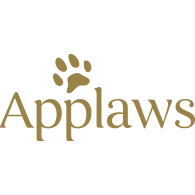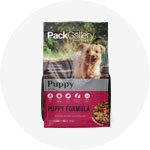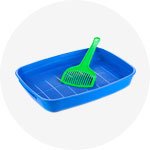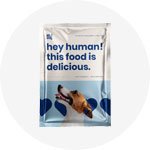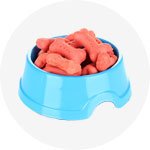Can Dogs Eat Cantaloupe: A Comprehensive Guide to Cantaloupe and Canine Nutrition
Dogs, often regarded as “man’s best friend,” share our homes, our hearts, and sometimes even our food. As responsible pet owners, we constantly strive to provide our furry companions with a diet that ensures their health and happiness. Fruits and vegetables, including the delicious cantaloupe, can be tempting to share with our canine friends. However, the safety and potential benefits of feeding cantaloupe to dogs remain a question for many. In this in-depth exploration, we will answer the pressing query: “Can dogs eat cantaloupe?”
In this article, we will delve deep into the subject of dogs and cantaloupe, examining the nutritional value, potential health benefits, risks, and necessary precautions associated with incorporating cantaloupe into your dog’s diet. By the end, you will have a comprehensive understanding of whether cantaloupe is a suitable addition to your furry friend’s menu and how to do so without compromising their well-being.
Can Dogs Eat Cantaloupe?
Yes, dogs can eat cantaloupe in moderation. Cantaloupe is a sweet and hydrating fruit that is generally safe for dogs to consume as an occasional treat. Here are some key points to consider when feeding cantaloupe to your dog:
- Moderation is Key: While cantaloupe is safe for dogs, it should be given in moderation. Like many fruits, cantaloupe is naturally high in sugar, and excessive consumption can lead to an upset stomach or diarrhea. Treat it as an occasional snack, not a regular part of your dog’s diet.
- Remove the Seeds and Rind: Before offering cantaloupe to your dog, make sure to remove the seeds and the tough rind. The seeds may pose a choking hazard, and the rind can be difficult for dogs to digest.
- Small, Bite-Sized Pieces: Cut the cantaloupe into small, bite-sized pieces to make it easier for your dog to eat and reduce the risk of choking.
- Wash and Serve Fresh: Ensure that the cantaloupe is clean and fresh. Wash it thoroughly before serving to remove any pesticides or contaminants.
- Monitor for Allergies: As with any new food, observe your dog’s reaction when they try cantaloupe for the first time. Some dogs may have allergies or sensitivities to certain fruits. If you notice any adverse reactions, such as digestive upset or allergies, discontinue feeding cantaloupe.
- Low in Calories: Cantaloupe is relatively low in calories, making it a healthier option than some other fruits for an occasional treat. It’s also a good source of vitamins A and C.
While cantaloupe can be a refreshing and nutritious treat for your dog, it should not replace their regular balanced dog food. Always prioritize a balanced diet tailored to your dog’s specific needs, and consult your veterinarian if you have any concerns about adding new foods to their diet.
Can Dogs Eat Cantaloupe Rind
While dogs can safely consume the flesh of cantaloupe as an occasional treat, it’s generally not advisable to feed them the rind. The rind is tough, fibrous, and difficult for dogs to digest. Ingesting the rind can lead to gastrointestinal issues, including blockages or upset stomach. To ensure your dog’s safety and digestive health, always remove the rind and seeds before offering them cantaloupe. Stick to the flesh of the fruit, cut into small, bite-sized pieces, for a safe and enjoyable treat.

Can Dogs Eat Watermelon and Cantaloupe
Both watermelon and cantaloupe are generally safe for dogs when offered in moderation. They can serve as refreshing and hydrating treats, especially on hot days. However, it’s crucial to follow some guidelines:
- Watermelon: Dogs can eat watermelon, but you should remove the seeds and rind before serving. Watermelon is mostly water and low in calories, making it a healthier choice for a dog treat. Just remember that, like any treat, it should be given in moderation.
- Cantaloupe: As previously mentioned, cantaloupe is also safe for dogs when the seeds and rind are removed. It’s sweet and a good source of vitamins. However, due to its sugar content, it should also be an occasional treat in your dog’s diet.
When sharing watermelon or cantaloupe with your dog, cut the fruit into small, manageable pieces to avoid choking hazards. Observe your dog for any adverse reactions, especially when introducing a new food. Moderation is key to prevent digestive upset, as both fruits contain natural sugars. While these fruits can be a healthy and tasty addition to your dog’s diet, remember to prioritize their regular balanced dog food and consult your veterinarian if you have any concerns about your dog’s diet or potential allergies.
Nutritional Benefits of Cantaloupe for Dogs
Cantaloupe boasts a rich nutritional profile that can provide several advantages for dogs when consumed responsibly. Here are some of the critical nutrients found in cantaloupe and how they can contribute to your dog’s well-being:

1. Vitamins
Cantaloupe is a significant source of vitamins A and C, both of which are vital for a dog’s overall health:
- Vitamin A: This vitamin is essential for maintaining healthy vision, skin, and coat in dogs. It also plays a crucial role in supporting the immune system.
- Vitamin C: As an antioxidant, vitamin C helps protect cells from damage, boosts the immune system, and facilitates healing.
2. Fiber
The dietary fiber present in cantaloupe aids digestion and promotes regular bowel movements. This is particularly beneficial for dogs dealing with constipation or other digestive issues.
3. Hydration
Cantaloupe’s high water content makes it an excellent choice for keeping your dog hydrated, especially during hot weather. Adequate hydration is crucial for overall health and helps prevent conditions like heatstroke.
4. Antioxidants
Cantaloupe contains antioxidants, including beta-carotene, which help combat harmful free radicals within a dog’s body. This can potentially reduce the risk of chronic diseases and contribute to overall wellness.
5. Low-Calorie Option
With its relatively low-calorie content, cantaloupe can serve as a healthy alternative to high-calorie dog treats. It is particularly useful for dogs that need to maintain or lose weight.
Risks and Precautions of Cantaloupe
While cantaloupe can offer several nutritional benefits, it is important to be aware of the associated risks and take necessary precautions:
1. Portion Control
Feeding your dog excessive amounts of cantaloupe can result in gastrointestinal discomfort, including diarrhea and stomach cramps. It is crucial to introduce cantaloupe gradually into your dog’s diet and monitor their response.
2. Seed and Rind Removal
Cantaloupe seeds and rind pose choking hazards and may be challenging for dogs to digest. Always ensure you remove all seeds and the tough rind before offering cantaloupe to your dog.
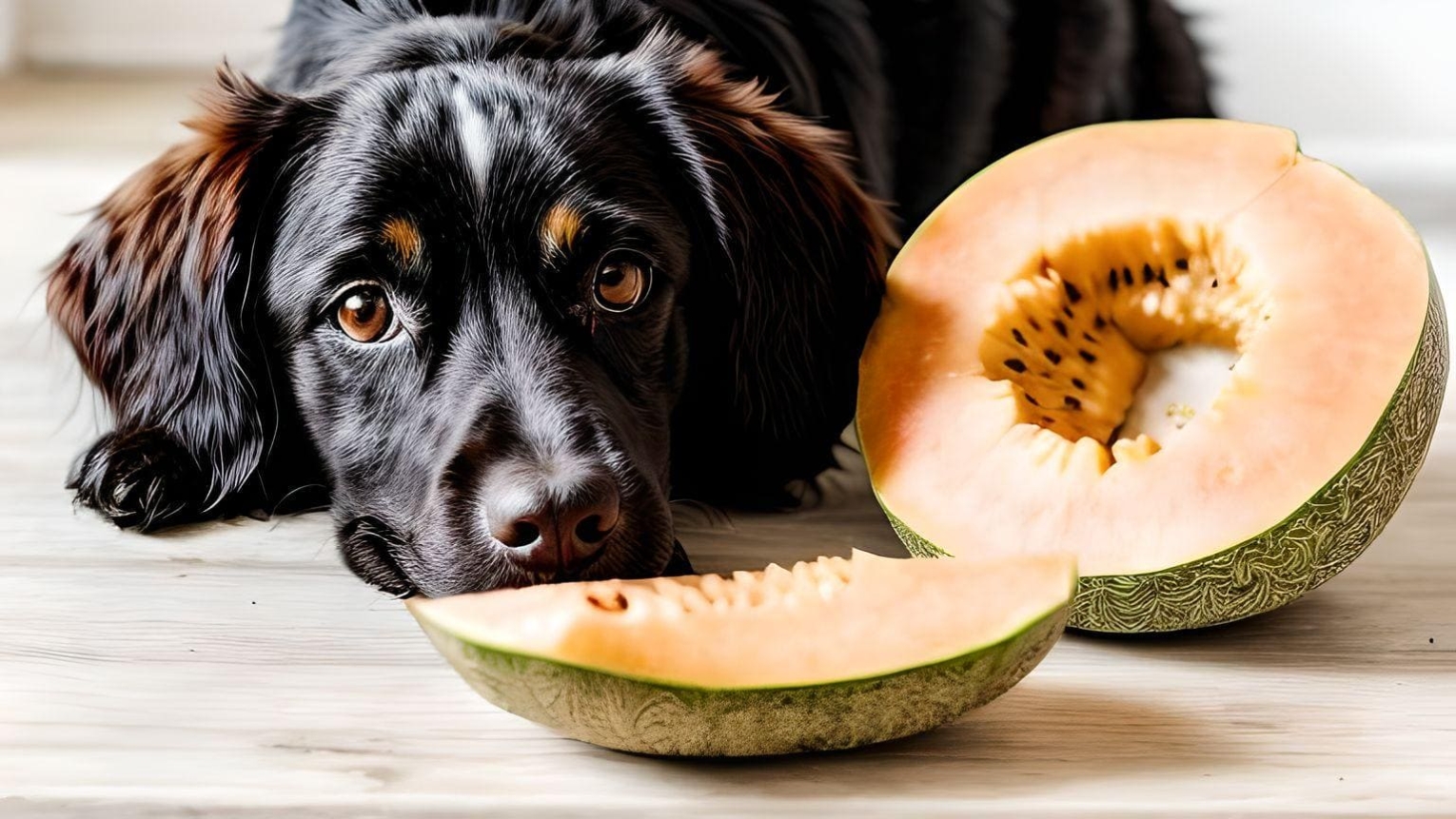
3. Allergies
Just like humans, dogs can develop food allergies. When introducing cantaloupe for the first time, closely observe your dog for any signs of an allergic reaction, such as itching, hives, or gastrointestinal distress. If any adverse reactions occur, immediately discontinue feeding cantaloupe.
4. Natural Sugars
Cantaloupe contains natural sugars, which, when consumed in excess, can contribute to obesity and dental issues in dogs. Remember to practice moderation when using cantaloupe as a treat.
5. Diabetic Dogs
If your dog has diabetes, it is advisable to consult with your veterinarian before including cantaloupe in their diet. The sugar content in cantaloupe can impact their blood sugar levels.
6. Serving Method
To mitigate choking hazards, consider cutting cantaloupe into small, bite-sized pieces or mashing it before offering it to your dog. This not only reduces the risk of choking but also makes it easier for your dog to digest.
How to Introduce Cantaloupe to Your Dog
Now that you are familiar with the potential benefits and risks associated with cantaloupe for dogs, let’s discuss a step-by-step guide on how to introduce it safely:
- Select Ripe Cantaloupe: Choose a ripe cantaloupe that exhibits a sweet aroma and slightly yields to pressure when gently pressed. Avoid overripe or moldy fruit.
- Seed and Rind Removal: Thoroughly remove all seeds and the tough rind to prevent choking hazards and digestive issues.
- Cut into Appropriately Sized Pieces: Cut the cantaloupe into small, dog-sized pieces or mash it to make it easier for your dog to consume and digest.
- Begin with Small Portions: Initiate the introduction with a small piece of cantaloupe to gauge your dog’s response. If they tolerate it well, gradually increase the portion size over time, but always exercise moderation.
- Monitor for Allergic Reactions: Keep a close eye on your dog after introducing cantaloupe for any signs of allergies or adverse reactions.
- Limit Frequency: Cantaloupe should be regarded as an occasional treat and not a regular component of your dog’s diet.
Potential Benefits of Cantaloupe for Dogs
While cantaloupe offers a range of nutrients, there are specific potential benefits it can provide to your canine companion:
1. Improved Hydration
Cantaloupe’s high water content can help keep your dog well-hydrated, especially during warm weather. Proper hydration is essential for various bodily functions and helps prevent heat-related issues.
2. Enhanced Digestion
Dietary fiber in cantaloupe supports digestive health by promoting regular bowel movements. It can be particularly helpful for dogs that suffer from constipation or irregularity.
3. Antioxidant Protection
The presence of antioxidants, including beta-carotene, helps neutralize harmful free radicals in your dog’s body. This can potentially lower the risk of chronic diseases and contribute to long-term well-being.
4. Nutrient Boost
Cantaloupe is a nutrient-dense fruit, providing essential vitamins like A and C. These vitamins are critical for maintaining healthy skin, coat, and overall immune function in dogs.

5. Weight Management
For dogs that require weight management, cantaloupe can serve as a low-calorie treat option. It allows you to offer your dog a flavorful snack without contributing to excess calorie intake.
6. Variability in Diet
Introducing new and healthy foods, like cantaloupe, into your dog’s diet can add variety and prevent dietary monotony. This can make mealtime more enjoyable for your furry friend.
Risks and Considerations of Cantaloupe
Despite the potential benefits, it’s essential to be aware of the associated risks and considerations when feeding cantaloupe to your dog:
1. Gastrointestinal Upset
Feeding cantaloupe in excessive amounts can lead to gastrointestinal upset, causing symptoms such as diarrhea, stomach cramps, or gas. It is vital to control portion sizes and monitor your dog’s response.
2. Choking Hazard
Cantaloupe seeds and rind can pose a choking hazard to dogs, especially if they attempt to swallow them whole. Always remove these parts before offering cantaloupe to your pet.

3. Allergic Reactions
Dogs, like humans, can develop food allergies or sensitivities. When introducing cantaloupe, watch for signs of allergies, such as itching, hives, or gastrointestinal distress. If any adverse reactions occur, discontinue cantaloupe consumption.
4. Sugar Content
While natural sugars in cantaloupe are generally not harmful, excessive consumption can contribute to weight gain and dental issues in dogs. Moderation is key, especially for dogs prone to obesity.
5. Diabetic Dogs
If your dog has diabetes or other metabolic disorders, consult your veterinarian before including cantaloupe in their diet. The fruit’s sugar content may affect their blood sugar levels and necessitate adjustments in their insulin regimen.
6. Individual Tolerance
Each dog is unique, and their tolerance to new foods can vary. Some dogs may tolerate cantaloupe well, while others may experience digestive discomfort. Always monitor your dog’s response and tailor their diet accordingly.
How to Safely Feed Cantaloupe to Your Dog
To ensure the safety and enjoyment of cantaloupe for your dog, follow these guidelines:
- Opt for Ripe Cantaloupe: Choose ripe cantaloupe with a sweet aroma and slightly yielding texture when gently pressed. Avoid fruits that are overripe or show signs of mold.
- Seed and Rind Removal: Thoroughly remove all seeds and the tough rind from the cantaloupe. These parts can pose choking hazards and may be challenging for dogs to digest.
- Appropriate Size and Consistency: Cut the cantaloupe into small, dog-friendly pieces or mash it to create a texture that is easy for your dog to consume and digest.
- Begin with Small Portions: Initiate the introduction with a small piece of cantaloupe to assess your dog’s reaction. If they tolerate it well, gradually increase the portion size over time, but always practice moderation.
- Monitor for Allergic Reactions: Keep a close watch on your dog for any signs of allergies or adverse reactions after introducing cantaloupe. These may include itching, hives, or digestive distress. If any such reactions occur, cease cantaloupe consumption.
- Limit Frequency: Cantaloupe should be considered an occasional treat and not a regular component of your dog’s diet. Excessive consumption can lead to imbalances in their nutrition.
Conclusion:
In conclusion, cantaloupe can be a safe and nutritious treat for dogs when introduced thoughtfully and with consideration of potential risks. Its rich nutritional profile, including vitamins, fiber, hydration, and antioxidants, can offer several health benefits to your furry companion. However, it is crucial to exercise caution and moderation when feeding cantaloupe to dogs, as individual tolerances and sensitivities can vary.
Before introducing any new food to your dog’s diet, especially if they have specific health concerns or dietary restrictions, consult with your veterinarian for personalized guidance. By following the guidelines outlined in this comprehensive guide, you can safely share the joy of a sweet and refreshing cantaloupe treat with your beloved canine friend, while ensuring their health and well-being remain a top priority.
Frequently Asked Questions on Cantaloupe
-
Can Puppies Eat Cantaloupe?
Puppies can safely consume cantaloupe in moderation once they have transitioned to solid foods. It is crucial to introduce new foods gradually and monitor their response.
-
Can Cantaloupe Be Given to Dogs with Allergies?
Dogs with known food allergies should be introduced to cantaloupe with caution. Observe their reaction for any signs of allergies or sensitivities and consult your veterinarian if necessary.
-
How Should I Store Cantaloupe for My Dog?
Store cantaloupe in the refrigerator to maintain freshness. If you plan to offer it to your dog, ensure it is cold but not too cold to avoid discomfort.
-
Can Diabetic Dogs Eat Cantaloupe?
Diabetic dogs should only consume cantaloupe under the guidance of a veterinarian. The fruit’s sugar content can affect blood sugar levels, necessitating adjustments in their insulin regimen.
-
Can Dogs Eat Cantaloupe Seeds?
Cantaloupe seeds should be entirely removed before feeding them to dogs. These seeds can pose choking hazards and may be difficult for dogs to digest.
-
Is There a Preferred Cantaloupe Variety for Dogs?
There is no specific cantaloupe variety preferred for dogs. However, opt for ripe, sweet-smelling cantaloupe to ensure the fruit is flavorful and appealing to your dog.
-
Can Dogs Eat Cantaloupe Skin?
The tough rind or skin of cantaloupe should be removed before offering it to dogs. The skin can be challenging for dogs to chew and digest.
-
Can Dogs Eat Cantaloupe Seeds and Rind?
It’s important to remove cantaloupe seeds and the tough rind before feeding them to dogs. These parts can pose choking hazards and may be difficult for dogs to digest.
-
Are There Any Cantaloupe Varieties That Are Harmful to Dogs?
While most cantaloupe varieties are safe for dogs, it’s essential to avoid any melons that have become moldy or spoiled, as these can be harmful to your pet.
-
Can Dogs Eat Cantaloupe Every Day?
Feeding cantaloupe to your dog every day is not recommended. It should be considered an occasional treat, and portion sizes should be controlled to prevent digestive issues and excessive sugar intake.
-
Can Cantaloupe Help with a Dog’s Bad Breath?
Cantaloupe’s high water content and natural sweetness can help freshen a dog’s breath temporarily. However, it should not replace proper dental care, including regular brushing and dental check-ups.
-
Can Dogs Eat Cantaloupe When They Have an Upset Stomach?
Feeding a small amount of plain, ripe cantaloupe may help soothe a mild upset stomach in some dogs. However, it’s essential to consult with your veterinarian if your dog’s stomach issues persist or worsen.
-
Can Dogs Eat Frozen Cantaloupe?
Frozen cantaloupe chunks can be a refreshing treat for dogs, especially on hot days. Just ensure the pieces are appropriately sized to prevent choking.
-
What Are the Signs of Cantaloupe Allergies in Dogs?
Signs of cantaloupe allergies in dogs may include itching, hives, swelling, gastrointestinal upset (such as vomiting or diarrhea), and changes in behavior. If you suspect an allergy, consult your veterinarian.
-
Can Dogs with Food Sensitivities Eat Cantaloupe?
Dogs with known food sensitivities or allergies should be introduced to cantaloupe cautiously, as it could trigger a reaction. Always consult with your veterinarian for guidance.
-
Can Cantaloupe Be Part of a Homemade Dog Treat Recipe?
Cantaloupe can be incorporated into homemade dog treats in moderation. There are various dog-friendly recipes available that include cantaloupe as an ingredient, but it should not be the primary component.
-
Is There a Recommended Serving Size for Dogs?
The recommended serving size of cantaloupe for dogs varies depending on their size and individual tolerance. As a general guideline, start with small pieces and monitor your dog’s reaction, gradually increasing the portion size if tolerated.
-
Can Dogs Eat Cantaloupe Popsicles?
Cantaloupe popsicles, made by freezing chunks of cantaloupe, can be a fun and refreshing summer treat for dogs. Ensure the pieces are bite-sized and easy for your dog to manage.
-
Are There Any Health Conditions That Contradict Feeding Cantaloupe to Dogs?
Certain health conditions, such as kidney disease or pancreatitis, may require dietary restrictions. Consult your veterinarian before offering cantaloupe to dogs with specific medical issues.
-
Can Cantaloupe Be Included in a Raw Food Diet for Dogs?
Cantaloupe can be a part of a raw food diet for dogs, but it should be incorporated in moderation and as part of a well-balanced diet. Consult with a veterinarian or canine nutritionist to ensure a balanced meal plan.
Can Dogs Eat Mushrooms | Health Issues, 5 Benefits, Risks, Nutritional Value
Can Dogs Have Honey | 4 Health Benefits, Causes, Risks, Health Issues








